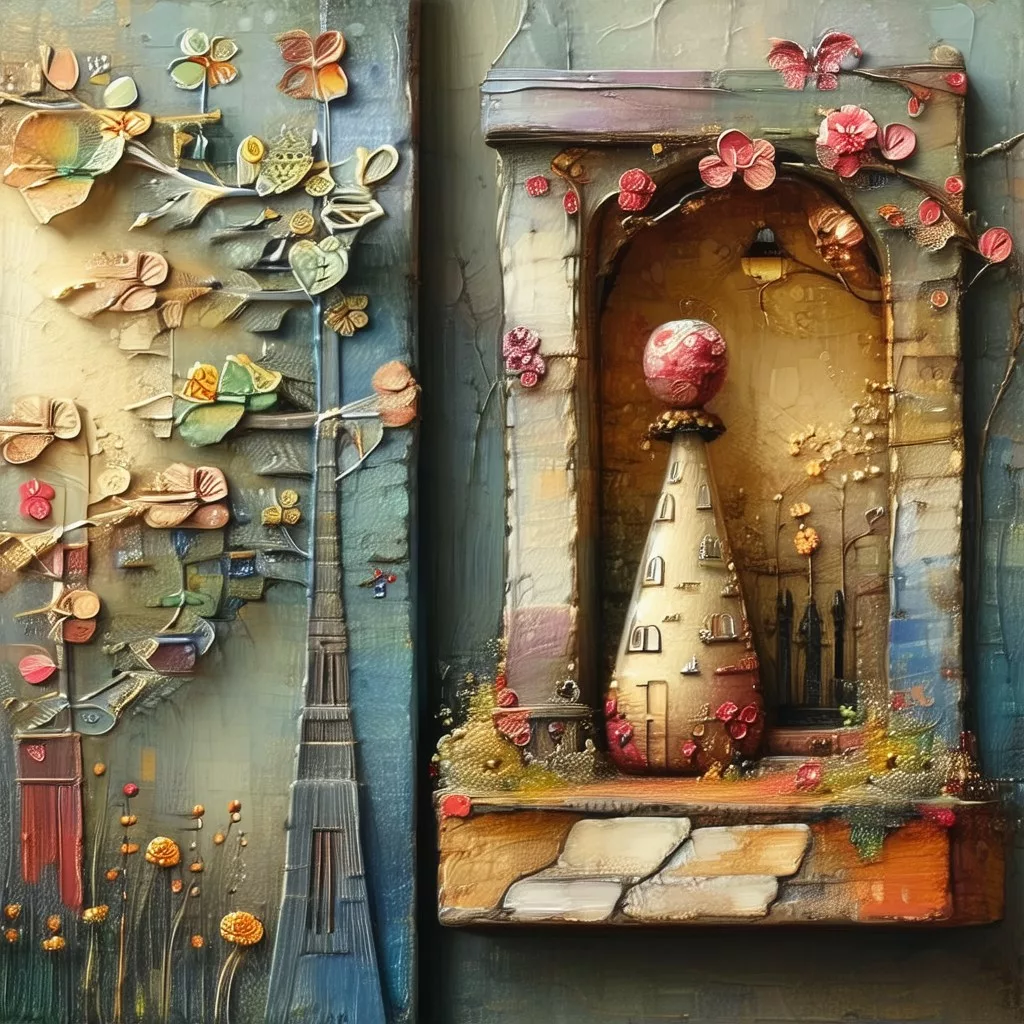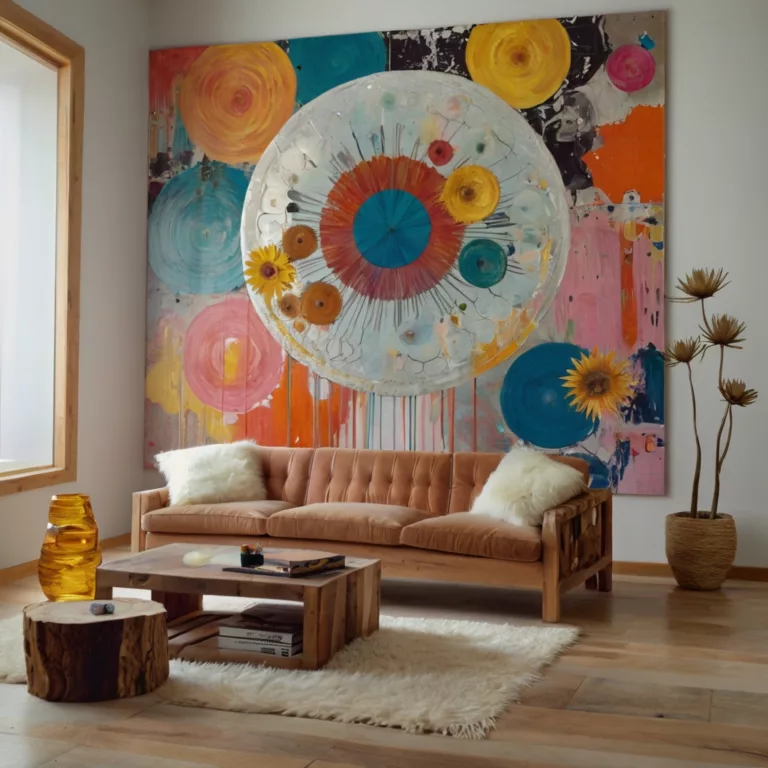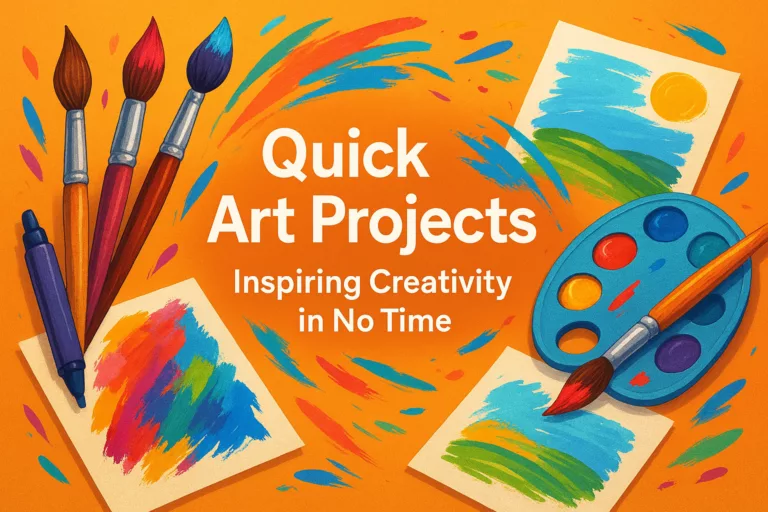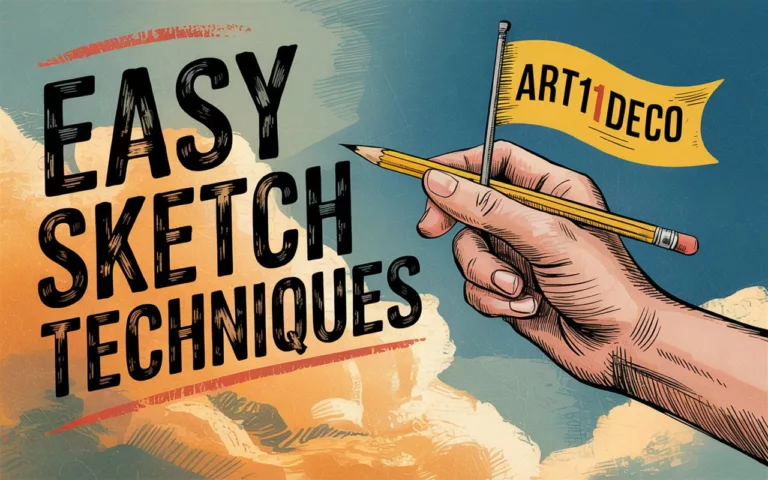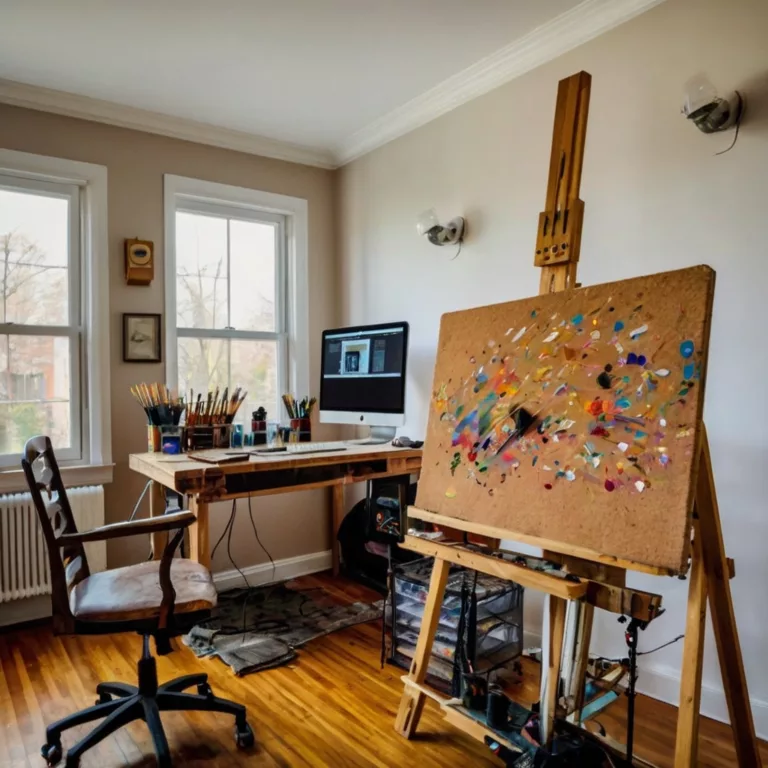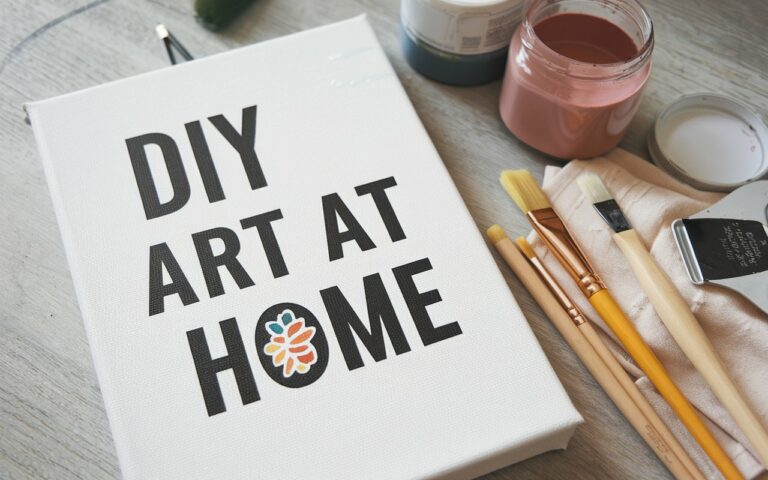Guide to Handmade Art: Ideas, Techniques, and Inspiration
In today’s digital age, there is something profoundly satisfying about creating art with your own hands. Handmade art not only allows for personal expression but also provides a therapeutic escape from the fast-paced modern world. The tactile experience of manipulating materials, the focus required for detailed work, and the pride in displaying something uniquely yours all contribute to the enduring appeal of handmade creations.
This comprehensive guide explores diverse handmade art forms, from traditional crafts that have been practiced for centuries to contemporary techniques that push creative boundaries. Whether you’re a seasoned artisan or a curious beginner looking to discover a new passion, this guide offers insights, practical tips, and inspiration to fuel your creative journey.
Traditional Handmade Art Forms
Paper Arts
Origami
Origami, the Japanese art of paper folding, transforms simple sheets of paper into three-dimensional sculptures without cutting or gluing. This ancient practice combines mathematical precision with artistic vision.
Getting Started with Origami:
- Begin with quality origami paper (though regular paper cut into squares works for beginners)
- Master basic folds: valley fold, mountain fold, inside reverse fold
- Start with simple models like cranes, boxes, or boats
- Progress to modular origami (using multiple sheets to create complex structures)
- Explore wet-folding techniques for curved, organic forms
Quilling
Quilling involves rolling thin strips of paper into coils and arranging them to create decorative designs. This delicate art form dates back to the Renaissance when monks and nuns used gold-edged paper from book edges to decorate religious items.
Essential Quilling Techniques:
- Basic coil: Roll paper strip tightly around a quilling tool
- Teardrops: Pinch one side of a coil
- Marquises: Pinch both sides of a coil
- Create intricate designs by combining various shapes
- Mount completed work on cards, frames, or jewelry
Papier-Mâché
This versatile technique uses paper strips or pulp mixed with adhesive to create sculptural forms. Papier-mâché originated in ancient China and has been used worldwide for everything from ceremonial masks to decorative bowls.
Papier-Mâché Project Ideas:
- Decorative bowls and containers
- Masks and theatrical props
- Sculptural art pieces
- Holiday ornaments and decorations
- Piñatas and celebratory items
Textile Arts
Embroidery
Embroidery adorns fabric with needle and thread in decorative designs. This ancient craft spans cultures worldwide, from Chinese silk embroidery to European blackwork.
Embroidery Styles to Explore:
- Cross-stitch: X-shaped stitches forming patterns on even-weave fabric
- Crewelwork: Wool thread on linen, creating textured designs
- Sashiko: Japanese running-stitch technique often in geometric patterns
- Hardanger: Norwegian whitework embroidery with cut and drawn threadwork
- Ribbon embroidery: Using silk ribbon for dimensional floral designs
Knitting and Crochet
These yarn crafts create fabric through loops made with needles (knitting) or hooks (crochet). Both techniques offer endless possibilities for creating wearables, home décor, and art pieces.
Creative Projects Beyond Basics:
- Amigurumi: Crocheted stuffed toys and figures
- Lace shawls and delicate accessories
- Textured wall hangings
- Sculptural art pieces
- Yarn bombing: Covering public spaces with colorful yarn creations
Weaving
Weaving interlaces two sets of threads at right angles to create fabric. From simple tabby weaves to complex tapestries, this ancient craft continues to evolve.
Modern Approaches to Weaving:
- Frame loom weaving for beginners
- Tapestry techniques for pictorial wall hangings
- Sculptural weaving incorporating unconventional materials
- Rigid heddle looms for functional textiles
- Experimental techniques like shaped weaving and 3D structures
Quilting
Quilting joins layers of fabric with stitches, traditionally creating bedcoverings. Modern quilting has evolved into a sophisticated art form with endless creative possibilities.
Contemporary Quilting Techniques:
- Art quilts: Pictorial and abstract compositions
- Improvisational piecing without patterns
- Thread painting: Dense stitching creating texture and imagery
- Trapunto: Stuffed quilting for dimensional effects
- Mixed media approaches incorporating painting, printing, and embellishment
Ceramics and Clay Arts
Hand-building
Hand-building techniques shape clay without a wheel, using methods like pinching, coiling, and slab construction to create vessels and sculptural forms.
Hand-building Methods:
- Pinch pots: Forming vessels by pinching clay between fingers
- Coil building: Stacking and joining clay coils
- Slab construction: Using flat clay pieces joined together
- Sculptural modeling: Creating figurative or abstract forms
- Texturing techniques using tools, textiles, and natural materials
Wheel Throwing
Pottery wheel throwing centers clay on a rotating wheel, using hands to shape it into vessels. This meditative process requires practice but offers rewarding results.
Tips for Beginning Potters:
- Master centering clay on the wheel
- Learn to open and pull cylinders before attempting more complex forms
- Understand the importance of even wall thickness
- Practice trimming to refine bases and profiles
- Explore various glazing techniques for surface decoration
Clay Sculpture
Sculptural ceramics range from figurative works to abstract forms, utilizing clay’s plastic qualities for expressive three-dimensional art.
Experimental Approaches:
- Mixed media integration with wood, metal, or fiber
- Alternative firing techniques like raku, saggar, or pit firing
- Carved and pierced forms revealing negative space
- Installation works combining multiple ceramic elements
- Narrative sculptural series exploring themes or stories
Contemporary and Emerging Handmade Arts
Mixed Media Collage
Collage combines diverse materials into unified compositions. This technique democratized art-making in the early 20th century and continues to evolve with contemporary artists.
Innovative Collage Approaches:
- Digital-analog hybrids incorporating printed and physical elements
- Dimensional collage extending into sculptural space
- Textural combinations of fabrics, papers, and found objects
- Photo-transfer techniques merging photography with handwork
- Narrative sequences telling stories through juxtaposed images
Eco-friendly and Upcycled Art
Creating with sustainable materials and repurposed objects addresses environmental concerns while producing unique artworks.
Sustainable Art Projects:
- Weaving with plastic bags to create durable baskets and mats
- Sculpting with reclaimed wood and natural materials
- Creating paper from plant fibers and recycled materials
- Jewelry from upcycled electronic components
- Textile art incorporating clothing scraps and industrial waste
Digital-Handmade Hybrids
Blending digital technology with traditional handcraft creates innovative art forms that bridge technological and artisanal approaches.
Exploration Ideas:
- 3D printing components to incorporate into handcrafted works
- Laser-cut elements combined with hand-stitching or weaving
- Digitally designed patterns for hand embroidery or quilting
- CNC-carved molds for hand-cast objects
- Augmented reality enhancements for physical artworks
Handmade Books and Journals
Bookbinding combines paper arts, textile techniques, and structural engineering to create functional and artistic books.
Bookbinding Styles:
- Coptic stitch: Exposed spine allowing books to open flat
- Japanese stab binding: Decorative stitching visible on the spine
- Accordion books: Folded pages expanding to reveal continuous imagery
- Altered books: Transforming existing books into art objects
- Sculptural book forms challenging traditional codex structures
Materials and Techniques for Different Skill Levels
Beginner-Friendly Projects
For Newcomers to Handmade Art:
- Simple paper crafts: Origami, card making, paper beads
- Basic textile projects: Embroidery samplers, simple knitting patterns
- Clay work: Pinch pots, coil bowls, air-dry clay ornaments
- Introductory mixed media: Collage cards, decoupage boxes
- Beginner’s bookbinding: Pamphlet stitch notebooks, folded zines
Intermediate Skill Development
For Those Ready to Advance:
- More complex paper techniques: Quilling, pop-up mechanisms, paper cutting
- Intermediate textile work: Garment sewing, pattern design, weaving
- Pottery: Basic wheel throwing, glaze experimentation
- Expanded mixed media: Layered collage, image transfers, working with wax
- Enhanced bookbinding: Multiple-signature books, custom covers
Advanced Artisanal Techniques
For Dedicated Artisans:
- Master-level paper arts: Complex origami tessellations, paper sculpture
- Advanced fiber arts: Jacquard weaving, complex knitting design, art quilts
- Ceramics: Large-scale wheel work, sculptural forms, glaze formulation
- Sophisticated mixed media: Installation work, conceptual series
- Professional bookbinding: Fine binding, leather work, edition binding
Setting Up Your Creative Space
Essential Tools for Various Crafts
Paper Arts Essentials:
- Quality papers in various weights
- Precision cutting tools: craft knife, scissors, paper trimmer
- Adhesives: PVA glue, glue sticks, double-sided tape
- Scoring and folding tools
- Storage for paper collections
Textile Arts Setup:
- Various fabrics, yarns, and threads
- Needles, hooks, and specialized tools
- Cutting implements: fabric scissors, rotary cutter
- Measuring tools: tape measure, rulers, gauges
- Organizational systems for supplies
Ceramics Workshop Basics:
- Clay storage and recycling system
- Work surface and tools: wire tools, ribs, needle tools
- Kiln access (personal or community)
- Glazing supplies and safety equipment
- Cleanup station with proper wastewater management
Mixed Media Studio Necessities:
- Variety of substrates: papers, canvases, boards
- Adhesives for different materials
- Cutting and assembly tools
- Surface treatments: gesso, mediums, paints
- Protective finishes appropriate for materials
Workspace Organization and Ergonomics
Creating an Efficient Studio:
- Adequate lighting, preferably natural light supplemented with task lighting
- Ergonomic seating and work heights to prevent strain
- Organized storage visible and accessible
- Dedicated zones for different processes
- Proper ventilation for materials with fumes
Sustainable Studio Practices
Eco-Conscious Art-Making:
- Responsible material sourcing and waste reduction
- Water conservation strategies for wet processes
- Non-toxic alternatives when possible
- Energy-efficient equipment and lighting
- Materials recycling and repurposing
Finding Inspiration and Developing Your Style
Cultivating Creative Habits
Nurturing Creativity:
- Daily sketching or material exploration
- Maintaining an inspiration journal
- Regular visits to museums, galleries, and craft shows
- Cross-disciplinary research and reading
- Collaboration with other artists
Cultural and Historical Influences
Drawing from Traditions:
- Study historical craft techniques from various cultures
- Understand the social context of traditional crafts
- Respectfully incorporate elements from diverse traditions
- Research contemporary interpretations of traditional forms
- Develop personal innovations within established frameworks
Contemporary Trends in Handmade Art
Current Movements:
- Slow craft movement emphasizing process and mindfulness
- Digital-physical integration in traditional crafts
- Sustainable and environmentally conscious approaches
- Social practice and community-engaged craft
- Global-local dynamics in material sourcing and techniques
Sharing and Selling Your Handmade Art
Building an Online Presence
Digital Platforms for Artisans:
- Portfolio website showcasing your best work
- Social media strategies for different craft niches
- Online marketplaces specializing in handmade items
- Virtual exhibitions and digital showcases
- Email newsletters and communication with collectors
In-Person Opportunities
Physical Venues:
- Craft fairs and artisan markets
- Gallery exhibitions and submissions
- Artist cooperatives and shared studio spaces
- Pop-up shops and temporary installations
- Consignment arrangements with boutiques
Pricing and Valuing Handmade Work
Fair Compensation Considerations:
- Material costs accounting
- Time tracking and hourly rates
- Skill level and expertise valuation
- Market research for comparable items
- Factoring in overhead, photography, and marketing costs
The Therapeutic Benefits of Handmade Art
Mindfulness Through Making
Craft as Meditation:
- Focus on process rather than outcome
- Present-moment awareness during creation
- Rhythmic and repetitive actions as calming techniques
- Sensory engagement with materials
- Flow state achievement through immersive making
Art Therapy Applications
Healing Through Creation:
- Expressive arts for processing emotions
- Structured craft activities for anxiety reduction
- Community art projects for social connection
- Adaptations for varying abilities and needs
- Self-reflection through creative journaling
Building Resilience and Problem-Solving Skills
Craft as Life Skills:
- Developing patience through long-term projects
- Learning from mistakes and adaptations
- Building confidence through skill mastery
- Transferring creative problem-solving to other areas
- Finding satisfaction in tangible accomplishments
Conclusion
The world of handmade art offers boundless opportunities for creativity, personal growth, and connection. Whether pursued as a serious artistic practice, a profitable venture, or a meditative hobby, making things by hand connects us to ancient traditions while allowing for contemporary innovation. As technology continues to advance, the irreplaceable value of handcrafted objects and the human touch they embody becomes ever more apparent.
By exploring various techniques, experimenting with materials, and developing your unique artistic voice, you contribute to the rich ongoing tradition of human creativity. Each handmade item carries not just the imprint of your hands but also your unique perspective and creative spirit something no machine can replicate.
Whatever path you choose in your handmade art journey, remember that the process itself holds as much value as the finished pieces. The skills you develop, the challenges you overcome, and the joy you experience in creating are all integral parts of the handmade experience.
Art11deco

